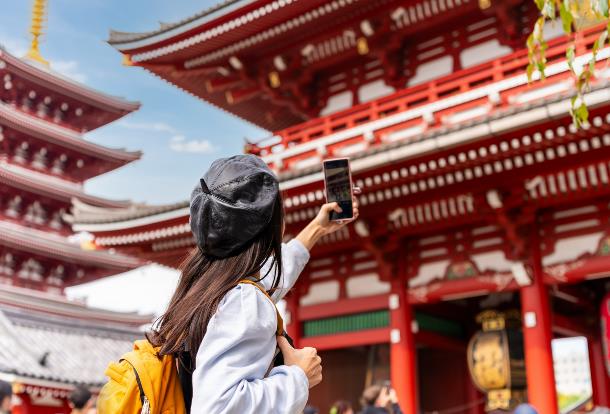
ChinaTravelNews, Ritesh Gupta - China is on a positive trajectory for inbound tourism, with recent policy changes yielding tangible results.
Specialists believe that a continued focus on accessibility – specifically through the expansion of visa-free policies and streamlining the entire travel process from planning to arrival and getting around – alongside other areas like regional diversification and innovative marketing strategies, will be key to further strengthening China’s positioning as a leading destination.
Recently, I had the fascinating opportunity to interact with Rebecca Smith, a seasoned expert from Wendy Wu Tours UK, about the landscape of inbound tourism in China.
Rebecca’s enthusiasm was palpable, particularly when reflecting on her recent return from China.
“Since my last visit,” she shared, “a major change has been the introduction of a visa-free policy for 38 countries. We’ve seen a significant surge in bookings from Ireland, Australia, and New Zealand.” This immediate impact underscores a crucial point: simplifying access is a powerful catalyst for tourism growth.
“We hope to see a similar visa-free policy introduced for the UK soon,” said Rebecca, Wendy Wu Tours’ Head of Product and Projects.
The hope for a similar visa-free arrangement for UK passport holders is strong, even as Wendy Wu Tours continues to navigate the current requirements with their inclusive visa service.
The decision to support inbound tourism with visa-waiver policies and visa-free transit initiatives is showing positive results. Beijing experienced significant growth, receiving 891,000 inbound tourists in the January-March period, a 61.3 percent year-on-year increase. Of these, 744,000 were foreign tourists (excluding those from Hong Kong, Macao, and Taiwan), marking a surge of 68.7 percent and representing 83.5 percent of the city's total inbound visitors. Overall, China recorded 163 million entries and exits in the first quarter of 2025, a 15.3 percent year-on-year increase. Notably, foreign national border crossings saw a sharper rise, reaching 17.44 million, a 33.4 percent increase from the same period in 2024, according to the National Immigration Administration (NIA).
What struck Rebecca most on her recent trip was a distinct shift in atmosphere. “Having travelled to China for many years, I’ve found that it feels more welcoming and accessible to international visitors than ever before.” This sentiment hints at a broader evolution within China’s tourism sector.
Rebecca believes that China is well-positioned to compete in Asia’s rapidly growing tourism market. Strengthening global perception and awareness will be key, particularly by ensuring travel remains easy and accessible, according to her.
Dos and Don’ts
Rebecca outlined key suggestions for China’s inbound marketing efforts.
*Promote China as a foreigner-friendly nation: The narrative needs to shift and loudly proclaim the ease of visiting. Highlight the smoother visa processes (and advocate for more!), the increasing adoption of mobile payment options (while ensuring traditional methods remain), and the impressive infrastructure, particularly the high-speed rail network that makes navigating this vast country a breeze.
“It’s never been easier to visit China,” said Rebecca.
One the core components of accessibility is how to pay as a foreign traveller. While mobile goes a long way in China, Rebecca pointed out that to accommodate non-tech-savvy travellers, traditional payment options should remain alongside digital ones. “While Alipay and WeChat Pay are convenient, many senior visitors prefer cash or cards,” mentioned Rebecca. Ensuring payment accessibility for all travellers, including those less comfortable with digital platforms, by maintaining traditional options is also crucial.
*Showcase the undiscovered gems: Beyond the popular attractions like the Great Wall, Pandas, and the Terracotta Warriors lies a gamut of diverse regions waiting to be explored. Marketing efforts should actively highlight these lesser-known destinations – the stunning landscapes of Zhangjiajie, the rich cultural heritage of Chongqing, the tropical allure of Hainan. These unique destinations, often boasting traditional experiences and advanced infrastructure, cater to travellers seeking something beyond the well-trodden path. “Showcase unique destinations that offer traditional experiences, beautiful natural landscapes, and advanced infrastructure to entice travellers looking for something different,” mentioned Rebecca
*Leverage the vibrancy of festivals and events: China's calendar is rich with cultural festivals and modern events. These offer incredible opportunities to attract specific traveller segments and showcase the country’s dynamic spirit. Events can significantly boost a destination’s visibility. As observed with high-profile events like Taylor Swift’s Eras Tour, these initiatives provide a dual benefit of direct tourist spending and the global attention brought by the event’s coverage. “Expanding internationally recognised events will further enhance its appeal to global travellers,” said Rebecca.
*Avoid overgeneralisation: Marketing campaigns must tailor their messaging to reflect the distinct character of different provinces and cities. Highlighting the unique cultural nuances, culinary specialties, and natural landscapes of each region will resonate with a wider range of traveller interests. ““China is diverse, so tailor marketing to reflect the uniqueness of different provinces and cities to capture the interest of diverse traveller types,” she said.
Being ready
Specialists point out that over the past few years tourism marketing has moved on to cater to an evolving tourist profile that is increasingly seeking novel and authentic experiences over traditional sightseeing.
“To meet the evolving interests of travellers, it is essential to offer experiences that highlight China’s lesser-known yet equally captivating aspects—not only by exploring new regions but also by uncovering hidden gems and developing immersive activities within major cities,” said Rebecca.
The team at Wendy Wu Tours takes great care to ensure that every province and city it showcases embodies its unique cultural and historical essence, allowing it to resonate with a diverse range of traveller types.
“China is a multifaceted destination that extends far beyond its most famous landmarks,” she said. The team collaborates closely with tourism offices and conducts extensive explorations to uncover the most authentic experiences and hidden gems, offering deep insights into a region’s cultural and historical essence.
“This approach enables us to tailor trips that appeal to a broad spectrum of interests, from history enthusiasts to adventure seekers,” she said. “For instance, consider Chongqing – a city where rich heritage seamlessly blends with rapid modernisation. Beyond the UNESCO-listed Dazu Rock Carvings, which immerse visitors in China’s cultural past, we also highlight Chongqing’s fabulous architecture and dynamic skyline, providing a glimpse into the city’s growth.” Combining this with the culinary experiences of world-renowned Sichuan cuisine creates an enriching journey for an array of travellers. “Furthermore, we actively move beyond the major hubs, introducing travellers to destinations gaining global attention, such as Zhangjiajie. Its stunning landscapes not only make it a paradise for nature lovers and photographers but also an emerging hotspot for those seeking unique, off-the-beaten-path adventures,” explained Rebecca.
These experiences can further be enhanced by apt use of technology, she added. “China’s ability to provide tech-enhanced, culturally rich travel experiences can set it apart in the global tourism market,” said Rebecca. “Technology is transforming the way travellers experience China, making visits more seamless, engaging, and immersive.”
Her company has embraced this approach by integrating innovative technologies into its tours. Examples:
*Drone food delivery: A unique high-tech dining experience where meals are delivered by drones, adding a futuristic touch to dining.
*On-site VR experience: Tourists in Zhangjiajie can indulge in immersive VR simulations, allowing them to ‘walk on clouds’ – all without leaving the ground. These experiences bring a new level of excitement to the region, making Zhangjiajie not just a sightseeing destination but an interactive adventure, said Rebecca.
As tourism grows outside the key cities, Rebecca says there is a growing need for more English-friendly services in these regions. Wendy Wu Tours is proactive in partnering with local tourism offices across China. These collaborations help bring more travellers to less-explored areas, ensuring they have the necessary support to navigate and enjoy these destinations.
Also, to support the growth of tourism beyond China’s key cities, more consistent and direct flight options to regional airports are essential. Currently, many international travellers face challenges with connecting flights, long travel times and inconsistent flight schedules when travelling beyond Shanghai and Beijing.
Campaigns
Wendy Wu Tours’ campaigns continue to highlight China’s unique and lesser-explored regions, positioning them as must-see destinations for international travellers.
Recently, the company collaborated with the Hunan Tourism Office and Hainan Airlines to introduce Changsha and Zhangjiajie to the international market. “We brought together 100 key members from leading travel companies and influencers, resulting in a highly successful campaign. By leveraging both traditional media and social platforms, our campaign went viral, transforming Zhangjiajie and Changsha into must-see, bucket-list destinations. As a result, our tours to the Hunan province have quickly become some of our best sellers,” shared Rebecca.
“We urge local tourism offices to partner with tour operators who have a strong marketing presence and trade relationships, along with airlines that are well-connected in the region, to drive these impactful activations forward,” she added.
Finally, Rebecca outlined their content strategy, which prioritises “authenticity, engagement, and shareability.” Collaborations with travel influencers on platforms like Instagram play a key role in amplifying their reach and connecting with target audiences through genuine storytelling.




